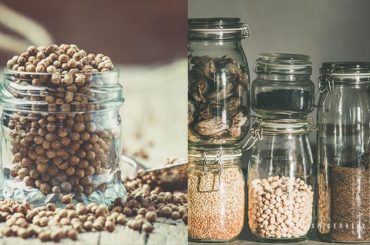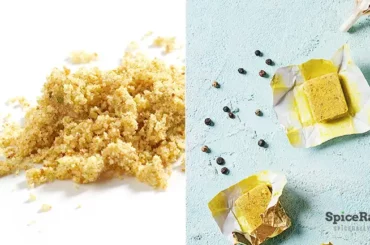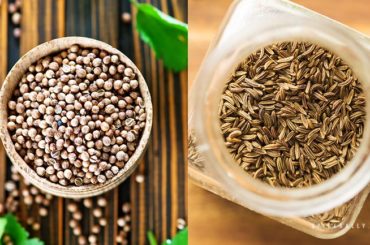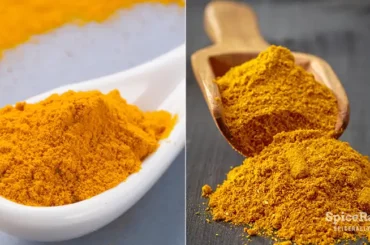With unique characteristics and flavoring elements, turmeric and cumin are two different spices incorporated into Indian dishes quite often. So, throughout this article, let’s dive into every detail about turmeric vs. cumin.
From appearance to flavor, many things about cumin and turmeric are different. Turmeric has a super earthy, milder taste, while cumin is potent with nutty, sweeter, and pungent notes. Moreover, turmeric is used in cooking primarily for flavor and coloring purposes, while cumin is basically for taste and fragrance.
So, keep reading to learn to clarify any doubts about these two pantry staples.
Turmeric vs Cumin
| Turmeric | Cumin | |
|---|---|---|
| Flavor Profile | Milder and bitter than cumin with super earthy, musky, and slightly peppery undertones. | Strong and pungent than turmeric with hearty, sweet, nutty, warm, and earthy notes |
| Fragrance Profile | The aroma profile is not yet clarified. But it is woodsy and mildly scented with hints of orange or ginger. | Warm, relatively nutty, earthy, and spicy aroma. Its smell intensifies when dry-roasted or put into the hot oil. |
| Forms used and availability | – As fresh rhizomes – Dried rhizomes – Powdered – Ground – As teas – Pills/ capsules – As an essential oil – Paste – Readily available in Asian grocery stores, supermarkets, and online shopping sites | – As a whole seed – In powdered/ ground form – As tea bags – As capsules – Readily available in Asian grocery stores, supermarkets, and online shopping sites. |
| Purpose in cooking | As an ingredient | As an ingredient |
| Usage in cooking | – Mainly used for color, flavor, and aroma. – Mostly incorporated into curries. – With spice and seasoning blends Mix into soups, stews, broths, and stir-fries. – It can be incorporated into savory rice dishes. – It is used to make Asian-inspired sweets and desserts. – Used to make healthy teas, smoothies, lattes and other beverages. | – Mainly used as a tempering spice in Indian cooking. – Used as a primary element in dry rubs, wet rubs, and marinades made for meat and fish. – It is incorporated into many spice blends and seasoning mixtures. – Is used to make candy, sweets, desserts, and other baked goods. – It is a great ingredient for making healthy beverages. – It can be integrated into sauces, chili, and chutneys. – Ground cumin could be combined into dips. |
| General use | – In cooking and baking – Asian communities like Hindus, Tamilians, and Buddhists integrate turmeric as a traditional ingredient for many of their religious and auspicious events. – Modern cosmetology and perfumery use this spice in making beauty products like creams, lotions, face wash, soap, etc. – Used in DIY beauty products like face masks and scrubs. – Used in modern and herbal medicine (Ayurveda and home remedies) | – In cooking and baking – Used as traditional carminative medicine. – Cumin extract is used in modern medicine. |
| Health benefits | – Reduces the inflammation in the body – It may function as an antidepressant – Boosts cardiovascular health – It contains antimicrobial properties that would be helpful for oral health – Helps in managing and preventing diabetes – Helps to prevent eye degeneration – Promotes skin health – Has anti-cancer properties – Helps to relieve the symptoms of osteoarthritis – Protects the liver | – Treats diarrhea – It contains antiseptic properties that safeguard the immunity system. – Has anti-cancer properties – Treats and relieves the symptoms of Irritable Bowel Syndrome (IBS) – May combat bacterial infections and parasites – It boosts the central nervous system, stimulates memory and cognitive function. – It assists in regulating blood sugar – Rich in anti-inflammatory effects. – Has a hypolipidemic substance that helps to lower harmful cholesterol levels in the body. – Promotes weight lossMain featuring cuisinesIndian, Sri Lankan, Thai, and Middle Eastern cuisinesIndian, Sri Lankan, Latin American, Cuban, North American, Mexican, and Middle Eastern cuisines. |
| Appearance | A bright yellow fleshy rhizome in its natural state and a vibrant yellowish-golden powder when pulverized. | Yellowish-brown in color and has an oval, longitudinally ridged shape that often resembles caraway and fennel seeds. It is brown in color when ground. |
| Scientific name | Curcuma longa | Cuminum cyminum |
| Plant family | Zingiberaceae (ginger family) | Apiaceae (parsley family) |
| Active compounds | Curcuminoids/ curcumin | Volatile oils (cuminaldehyde, cymene, terpenoids) |
| Origin | Southern India and Indonesia | Central Asia, Southwestern Asia, or Eastern Mediterranean |
| Shelf life | – Fresh turmeric will stay well for about 6-9 months in the freezer – Powdered turmeric will last up to 3-4 years if stored in an air-tight glass container in a dry, dark, cool place. | Both ground and whole cumin will stay well for up to 3-4 years. But, ground cumin tends to lose its potency sooner than whole cumin seeds. |
More Insights Into The Difference Between Turmeric And Cumin…
As you see, the most apparent difference between turmeric and cumin is how they look. Turmeric is basically a rhizome, while cumin is a seed of a plant. And above all, turmeric is commonly used as a colorant spice, while cumin is used for its distinctive flavor and aroma.

Another situation where most of us get confused is with curcumin in turmeric and cumin. Well, curcumin is the primary active compound (the yellow pigment) found in turmeric, whereas cumin has nothing to do with it. In fact, cumin is a single, whole spice.
These two spices have their own way of adding flavor, aroma, and color to a wide variety of foods. And when compared with cumin, turmeric has the capability of complementing many dishes. And turmeric comes in many states, while cumin mainly comes in whole and ground forms.
However, you should remember that these two spices are way different than being similar. In fact, cumin is not recommended as a substitute for turmeric and vice versa. But, they are used together in many foods since they make a good couple in terms of taste, contributing to the overall flavor of the dish.




